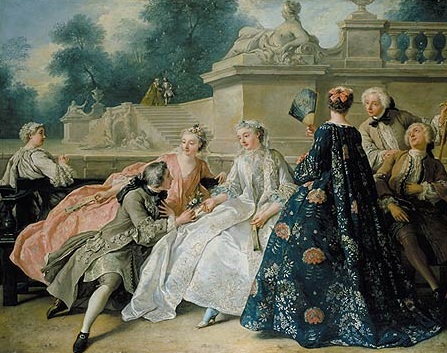La Déclaration de l'Amour 1731

Court etiquette – here a picture of the French court – placed great importance on the role played by clothing, which was important not only for its sumptuous display, but as a set ritual of court communication. Female dress, the robe à la française, was characterized by a manteau, consisting of a bodice and robe and the panier en coupole, a type of flexible hoop skirt made of select, ornately decorated damask with a train in attractive, bright colours. The man is wearing a juste au corps richly decorated with buttons and bows, a waistcoat, breeches and stocking, all of the finest silk. The male clothing appears feminine by today's standards, but it corresponded to the tastes of the time and was in no way considered unsuitable for a man.
Jean François de Troy (1679–1752), La Déclaration de l'Amour, oil on canvas, 1731, photographer: Jörg P. Anders; source: © Stiftung Preußische Schlösser und Gärten Berlin-Brandenburg, https://brandenburg.museum-digital.de/object/7338,  Creative Commons Attribution-NonCommercial-ShareAlike 4.0 International (CC BY-NC-SA 4.0), https://creativecommons.org/licenses/by-nc-sa/4.0/.
Creative Commons Attribution-NonCommercial-ShareAlike 4.0 International (CC BY-NC-SA 4.0), https://creativecommons.org/licenses/by-nc-sa/4.0/.